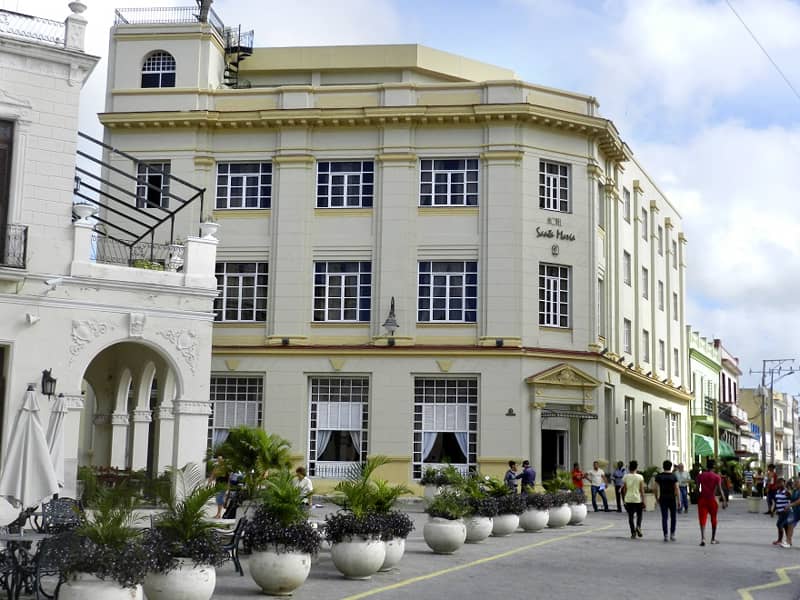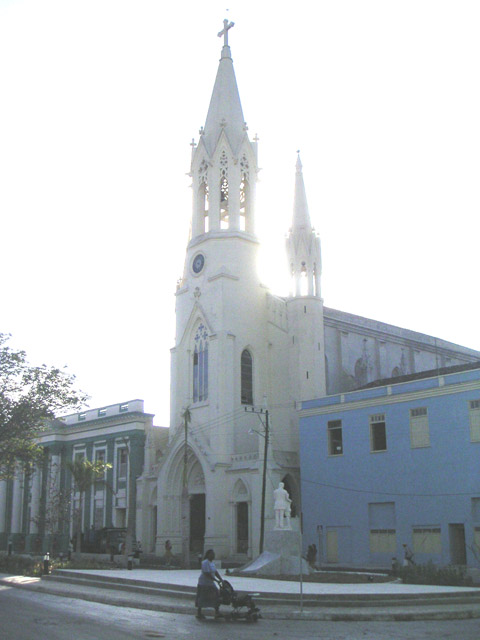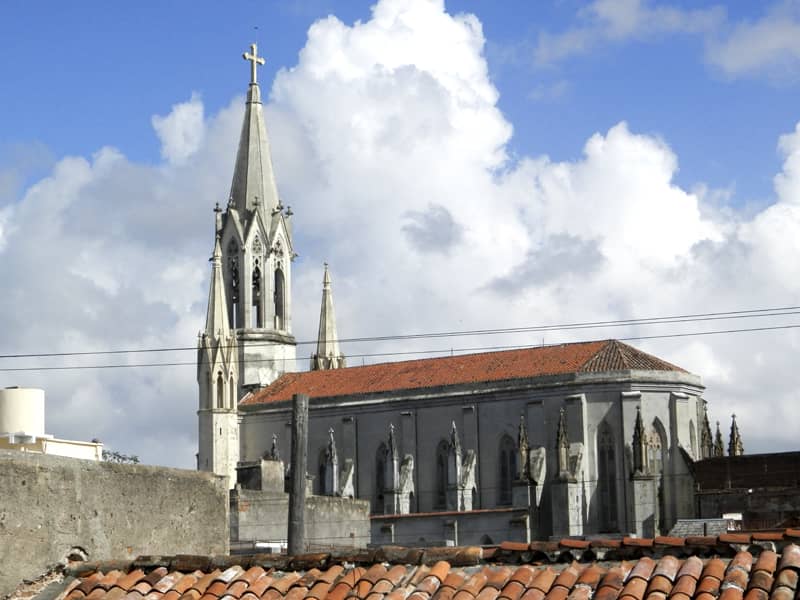PROVINCE OF CAMAGUEY
Dominated by plains the Camagueyan
province, the largest in the country, has a surface area of some 16
thousands kilometers square, of which more than a hundred correspond
to beach zones, which give the province enormous turistic potencial.
In this enviroment a traquil paradise of 20 kilometers of white sandy
beach, know as Playa Santa Lucia, approximately 80 km. from the City of Camaguey, distinguishes itself
in the northern coast of the province, with the encharments of its
silent nature, interrupted only by shouts of seagulls and flamingos.
In front of the coast there is the largest expanse of coral formations
on the island that extends for some 36 kilometers, in charge of protecting
the coast from impetuous currents from the Old Bahamian Channel. This
coral formation abounds with exceptional places for deep sea diving,
whether abrupt or irregular sea depths, tunnels and caverns, tubular
sponges, black and brown corals, big sea-fans and sunken ships, the
last being perfect refuges for marine life.
Embarcations and special teams
are avaiable to visitors at both diving centres, and there is a marina
which invites the guests to know the great blue Carribean by deep sea
fishing, daily and nocturnal immersions and to a witness a sensational
shark show.
For lovers of acquatic sports there is an ample supply of water scooters
and acquatic bicicles, row boats, sailing boats and catamarans, complemented
by bow and arrow facilities and horse sports.
From Santa Lucia one could visit the Las Cocos beach, and nearby a lagoon
which serves as habitat to a colony of flamingos. A catamaran cruise
takes the tourists to the nearby off-shore island Sabinal which is part
of a protected area for natural resources along with the Romano and
Guajaba Islands, with a total extension of 34 651 hectares and recognized
quality beaches such as Bonita,
Los Pinos and Brava beaches. From there, various
excursions take the visitors towards the entry canal of Nuevitas Bay,
to the south east of the beach, a tour which includes a visit to the
bird sanctuary and to the Ballenatos Islands, including also a tour
of the Cubitas Mountain Range, a reserve with more than 300 plant species,
some indigenous to the area.
The islands which form the Jardines de la Reina Archipelago to the south, and
part of the so-called Sabana/Camagüey
to the north, compliment the offer of vergin beaches and abundant nature
avaiable to vaccacioners.
Is the biggest province in the country, with more than 14 thousands
square kilometers, its geography its characterize for extensive plain,
which make the province an ideal place to cultivate the sugar cane and
to shepherd a great number of cattle. This two activities are the most
economic important in this zone, followed by the rice and the citrics.
Camaguey
is not absent of nature beauty, in spite of the apparent monotony of
its plains, the rivers that cross it had been made marvelous green zones
and natural pool, figured in the limestone rock, like the well known
forms in the Maximo river, without reply in no other place in the country.
Their
key and little islands in the north and in the south are valuable reservation
of the flora and fauna and its beaches of whiteness sand and transparent
waters are waiting to be conquer.
The
province has 120 kilometers of beaches, almost the 25 percent of the
whole country, which convert it in the potential most important tourist
focus in Cuba. In Santa Lucia, with its 20 kilometers of beach, many
of them virgin and protected by a choral barrier, you can learn and
practice dive here. The best beaches in the zone are in the Boca, near
the access channel to the Nuevitas Bay, semi isolated and little visited.
Immerse in this water you can see an incredible choral variety (50 species),
more than 200 of sponge and 500 of tropical fishes, and like a thirty
spanish galleon and some ship sank from the II World War. Following
to the west, it can be find the Sabinal key joined to the island by
a road of stone. Romano and Cruz with 40 kilometers of beaches with
very fine sands, are ideal places for dive too. In this zone live an
important colony of pink flamingo on the Caribbean.

|
CAMAGUEY CITY
 Founded
in 1515 with the name of Santa Maria del Puerto del Principe by Diego
Velazquez (one of the seven villages founded by him, in the place known
as Punta del Guincho, at the west side of the Nuevitas Bay), the city
of Camaguey, its provintial capital, is also known as the City
of Tinajones because
of the abundance of enormous clay reservoirs used before time to store
rain water because of the limited supply available. They
made the now famous tinajones, a kind of vessel to stock water, following
the models of the spanish vessels that came from Spain with wine and
oil. They found that some local clays were easy to mold, resistant and
with refractory properties. With this clays began the manufacture of
big vessels named
as Tinajones to store the water. In that way surged the most important
ceramic industry in the country, which maintain its production in the actual days. Nowadays they are used to adorn gardens,
verandas and parks. Founded
in 1515 with the name of Santa Maria del Puerto del Principe by Diego
Velazquez (one of the seven villages founded by him, in the place known
as Punta del Guincho, at the west side of the Nuevitas Bay), the city
of Camaguey, its provintial capital, is also known as the City
of Tinajones because
of the abundance of enormous clay reservoirs used before time to store
rain water because of the limited supply available. They
made the now famous tinajones, a kind of vessel to stock water, following
the models of the spanish vessels that came from Spain with wine and
oil. They found that some local clays were easy to mold, resistant and
with refractory properties. With this clays began the manufacture of
big vessels named
as Tinajones to store the water. In that way surged the most important
ceramic industry in the country, which maintain its production in the actual days. Nowadays they are used to adorn gardens,
verandas and parks.
Originated initially as a costal villa, its inhabitans
decided to relocate into the interior to avoid constant threats from
corsairs and pirates, the meanwhile revolutionizing the infrastructure
and apparence of the extensive plains, which rapidly converted into
a community for families deeply rooted in their traditions.The
constant attacks obligated the first residents to move the city in 1516
to the border of the Caonao river, and in 1528 the city was settled
finally in the indian settlement known as Camaguelo Camaguebax, in the
center of the province. Very soon it lost this peculiar name and it
was called Puerto Principe, which was also changed. Today every body
calls it Camaguey.
Its colonial architecture survives
in the fenced mansions, with tiled roofs, gigantic wooden doors, interior
patios, plazas, churches and narrow streets, all of this loaded with
history of the facts of the independent gesture of the past century
against Spanish colonialism. Aspects of this struggle is shown to visitors
at the House Born (Casa Natal) of Ignacio Agramonte, converted into a museum where episodies of the life of the illustrous
Major General of the Ejercito Libertador are exhibited, famous for his
courage and intransigence.


|
|

